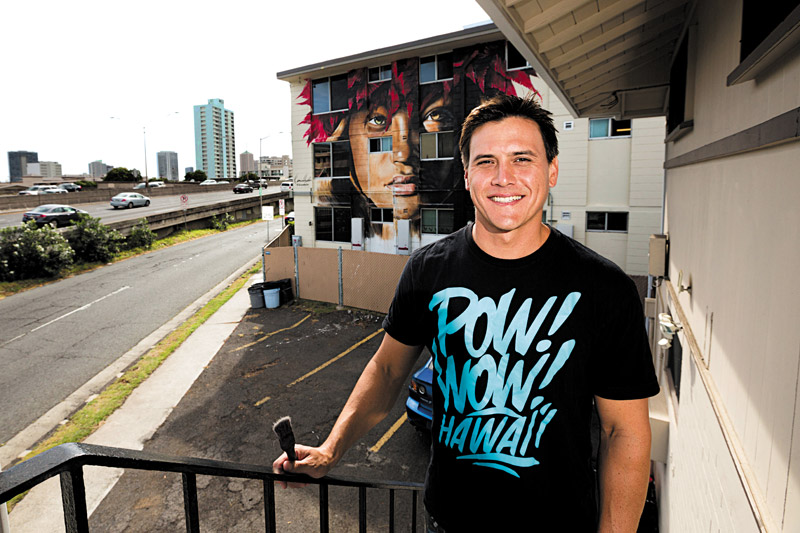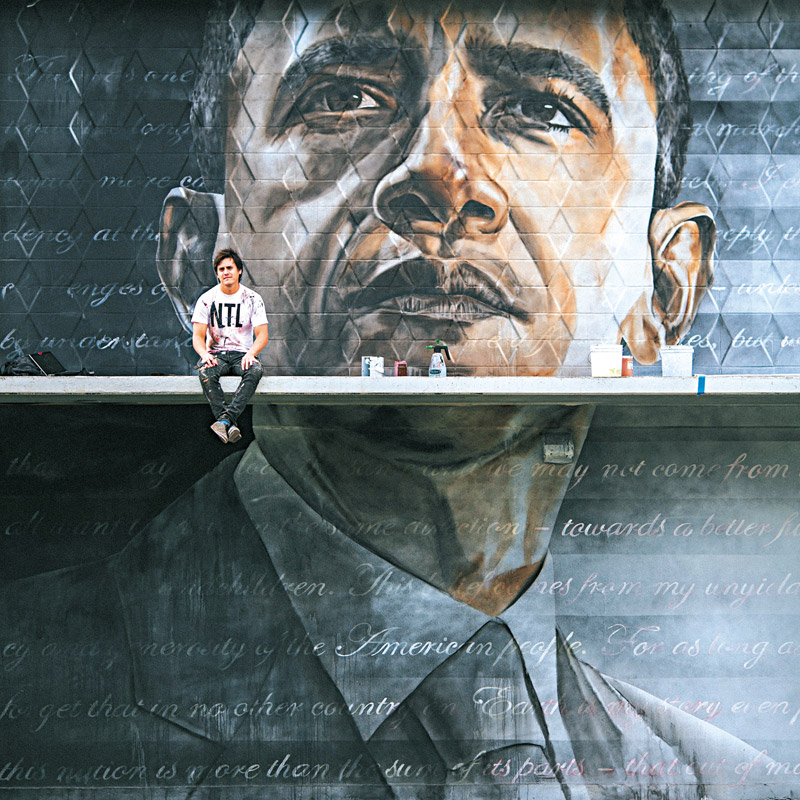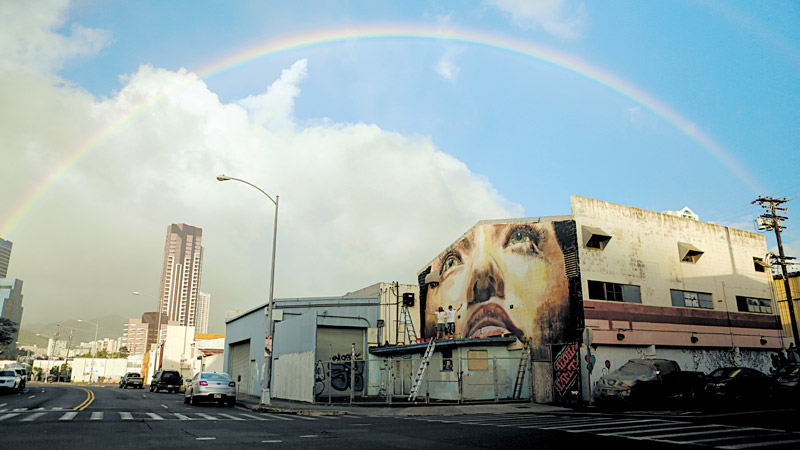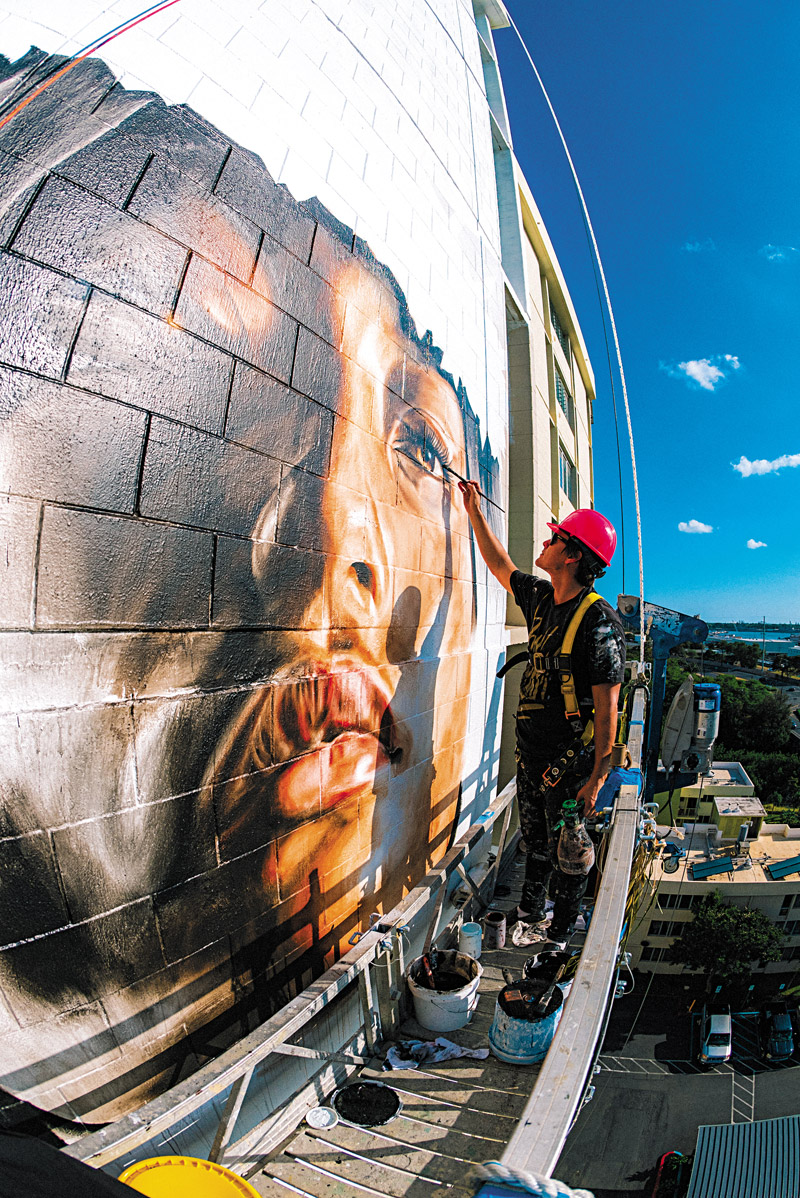Art And Soul

Kamea Hadar’s works include paintings of a woman on an apartment building at the Lunalilo exit off H1.
PHOTO COURTESY KAMEA HADAR
Street artist Kamea Hadar may be afraid of heights, but his “go-big-or-go-home” attitude is what makes him larger than life.
He was somewhere just below the seventh floor when Kamea Hadar, looking out from where he stood atop scaffolding, decided that he couldn’t go any higher. Hadar was less than halfway to the top of the location for his latest mural — the 14-story Halawa View Apartments, making this his biggest project yet — and with each rising floor, he became queasier, and more and more aware of the growing distance between himself and the ground.
An artist best known for large-scale murals, Hadar — and nobody ever believes him when he says this — is terrified of heights.
“There is a natural barrier you hit … It got to the point where I was like OK, stop, I can’t go anymore,” he says.
But then, instead of turning around, he did the exact opposite: He went right to the top.

Barack Obama on a Ward Avenue structure.
“I was like, ‘You know what, we are going to do it,'” he recalls. “And we went straight to the top, all the way up.”
He figured working his way down would seem tame in comparison. It was a bold move, and it worked.
Even if his name doesn’t sound familiar, you’ve probably seen his work. He’s one of the driving forces behind annual Kaka‘ako arts festival POW! WOW! Hawai‘i, and his detailed, ethereal portraits have become an integral part of the Honolulu landscape. The painting of a woman’s face on the apartment building at the Lunalilo exit off H1, the one across from Mother Waldron Park in Kaka‘ako, that one of Barack Obama on Ward Avenue — those are all Hadar. His work appears internationally, too — at a busy intersection in Taiwan, for instance — and has garnered mentions from the likes of CNN and Complex, where he earned a spot on a list of street artists to know.

Hadar’s ethereal masterpieces grace a Kaka‘ako building. PHOTOS COURTESY KAMEA HADAR
The go-big-or-go-home attitude that propelled him to finish the Halawa painting has been a hallmark of Hadar’s career as an artist, not only in the physical size of his murals, but more significantly, in his very approach to work. He sets prodigious goals, and does whatever it takes to go after them.
Just like in surfing, he says, “If you don’t fully commit to it, then you usually won’t make the wave. It’s all or nothing.
“If you want to do big projects, then you’ve got to risk something,” he says. “I am not going to let my fear dictate if I can do what I love or not.”
Different family members tell different stories, but at least according to his grandmother (and “you don’t argue with Grandma,” he quips), his artistic trajectory was set into motion with one fateful shopping trip when he was only 3 or 4 years old.

The 14-story Halawa View Apartments complex. PHOTOS COURTESY KAMEA HADAR
After returning home from the mall, Hadar told his grandma about a hat he’d seen. She offered to go back for it, if he could tell her what it looked like.
“I kept trying to describe it, and I couldn’t,” he explains. “Finally, I just drew a picture.”
Hadar doesn’t remember any of that, and he shrugs off the idea that he was any kind of child prodigy. (“I don’t know of any kid that doesn’t scribble or use crayons. Artists like myself, we just never stop.”) But apparently the picture was enough for his parents to put him in art classes. From that point on, painting and drawing were constants throughout his childhood and teenage years, even though spending Saturdays inside a studio wasn’t always his first choice.
“As a kid, you just want to go ride your bike. Later on, when I started surfing, all I wanted to do was surf with my friends. Art was just something that I took for granted.”

PHOTOS COURTESY KAMEA HADAR
“We always told him when he was kind of rebelling, ‘Listen, if you don’t want to do art later on, that’s fine, but you should at least keep the possibility open for yourself,'” recalls his mother, Nodie Namba-Hadar.
By high school, he was taking college art courses and working alongside his aunt, clothing designer Anne Namba. He even spent a summer in Paris studying at The Sorbonne. When he started college at University of Hawai‘i at Mānoa, it simply seemed like a given that he’d major in art.
After college, he did construction for his father, a contractor. He’d work for a few months at a time, long enough to save money for his next adventure — traveling across Europe, or sailing in Indonesia.
“All of a sudden, I didn’t have that structure of having a painting due for a class,” Hadar recalls. “I had no framework, and three years went by and I didn’t paint or draw anything. It was weird for me, and I kind of started feeling like something was missing … And that was when I really started to realize that (art) was something that I needed to do.”
When Hadar began showing his work in 2009, he took every opportunity he could get. An exhibit in a café? He was there. A wall to paint? He’d do it for free.
“Being an artist, any kind of artist, the whole first few years are just an investment,” he says. “You have to expect to make no money and you are just trying to get your name out there.
“If it is a good opportunity, you just say yes, and you’ll sleep next week. You don’t ever say no.”
During this time, Hadar was experimenting with his style. Portraiture was always something he enjoyed, he says, mainly because he is infinitely intrigued by even the mundane details of other people’s lives.
“My dad always makes fun of me because whomever I sit next to on a plane, I can have a conversation with them,” he says. “A lot of my inspiration comes from people … Everyone has their own world, their own hobbies, things they are into. I find that all really interesting.”
In 2010, Hadar got a call from Jasper Wong, a former classmate at Kalani High School. The two hadn’t been that close — by Wong’s account, ” He was a popular, good-looking guy, and I was a nerd” — but Wong was putting together the first POW! WOW! Hawai‘i, and he needed a place to house visiting participants. At the time, Hadar had recently finished helping his parents build an artists’ retreat on the North Shore.
“It was this weird coincidence,” Hadar reflects. “It felt like fate.”
Wong quickly found that Hadar “brought more to the table” than housing, and the two became co-lead directors for POW! WOW! Today, the once-grassroots event runs in cities throughout the world, encompasses an art and music school, and attracts international artists.
“Kamea works hard and is incredibly passionate,” Wong says. “We’ve been best friends for many years. He’s intensely loyal and reliable.
An all-around good dude. Who wouldn’ t want him on your side?”
Each year, in POW! WOW!’s most visible activity, artists adorn walls throughout Kaka‘ako with giant murals. Although Hadar had trained in more traditional art forms (he likes to joke that while his POW! WOW! friends were out doing the equivalent of break-dancing, he was learning ballet), he started collaborating on these projects.
For his family, it was an impressive, if nerve-wracking, transition to witness.
“It’s unbelievable; I don’t know how he does it,” says Namba. “I helped him with one mural. I am painting in it, and then I step back, and it’s like, wow, how did that happen? I was amazed. I still am amazed.”
Hadar found that he relished the impact that this format has —”People aren’t used to seeing murals on buildings or on the freeway” — as well as its inherent challenges. “It is always fun to challenge myself with a window here, or a gutter there. The whole point is you’re trying to use an unexpected canvas, so you’re going to have unexpected obstacles.”
Hadar started painting bigger murals, continually pushing himself toward larger walls — and larger goals. In 2013, he collaborated with Australian street artist Rone on a painting of his wife’s face in Kaka‘ako. His largest project at the time, it propelled him to go further.
“Once you go big once, you know the sky is the limit,” he says.
“It opened a whole new world to me where I felt like I wanted to go exponentially bigger.”
He’s not shy about making the scope of his ambitions known. At one meeting with The Modern to discuss potential collaborations, he suggested that he paint the entire hotel. At another meeting with Hawaiian Airlines, he said he wanted to paint an airplane. They laughed. No, he tried to explain, he was serious.
While both proposals were rejected, both lead to other, smaller projects: He’s painted a few murals inside of The Modern, and the ground service vehicles at Hawaiian Airlines.
“That is how a lot of my projects come about,” he says.
“And I think that is like a lot of my peers who are successful — they reach for the stars and they get in over their heads, and then they figure it out.”
Looking back, Hadar muses that part of why he hadn’t been entirely serious about pursuing a career in art when he was younger was because he knew he wanted to live in Hawai‘i. But he’d always gotten the impression that having a career as an artist and living in Hawai‘i were mutually exclusive.
“I didn’t know if it was even possible,” he recalls. “The idea of being able to be an artist was kind of exciting, but if I had to live in LA or New York, I wasn’t interested.”
It’s the sort of complex that probably vexes a lot of Hawai‘i kids across various industries — the idea, as Hadar explains it, that everything in Hawai‘i comes with “an asterisk of, ‘well, it’s Hawai‘i … meaning, oh the museum is good, for Hawai‘i.”
Looking ahead, changing that is another one of Hadar’s big goals: He hopes to provide artistic opportunities for kids, and foster a vibrant local art scene.
“I always say that I want to leave this world a more beautiful place than I found it,” he says. “If I am going to leave this world a more beautiful place, it’s physically by painting and beautifying actual buildings, and also creating an industry and a culture that the next generation can survive on and love.”
For more information, visit kameahadar.com.






